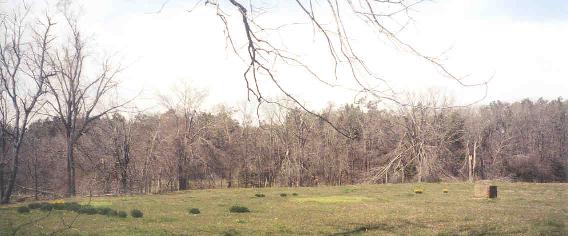
A well in our yard and an abandoned well down the back end!
We had a well in our yard, very near the house, just west of the Macedonia cemetery - going toward the Old Central School house, that was used for "drinking water". The water was very good and was so refreshing on a hot summer day. We had a nice shed built over our well and vines grew on two sides of the shed, giving shade underneath. The water from the well in the pasture was used to fill the black, iron wash pot that Mama boiled the white clothes in. Also to fill the two tubs, one was used to wash the colored clothes and the other to rinse the clothes in. That well had no shed over it, so there was no place for a pulley to run a rope through. It was covered with boards. I would only put back one of the boards when I would pull up a bucket of water. We just had a bucket tied onto a rope that we threw down into the well and pulled up the bucket of water. It was not very deep and when the creek nearby "was up" the well water was up also, nearly even with the ground. Sometimes it even looked a little muddy and we couldn't wash then. My brother, Lem, built my Mom a "washhouse" and we thought that was so fancy! It took her all morning to do the washing. I can remember that the wells were "cleaned out" once in awhile, but none of my family members would do that. There were men that did "well cleaning". I remember the cover on our well in the yard. It just looked like a small screen door that you would raise up and let down. Our well had no pump. We didn't have electricity in that house until 1948 I think. I had left home already when they finally got it. Wanda Adams nee Kelly. Posted June 2001.
Everyone in Oden had a well! There wasn't any other source of water. Number 4. well is just east of the Oden Post Office. A white two story house was still standing here in the 1960s. The Ike Chapman home had a nice well with cold, sweet water at the Oden house and a year round natural spring on the hillside directly behind the Oden school gymnasium. The spring is still there, still running and providing water for many of the little pastures and gardens there. A lot of the wells have been filled in and the well casings broken up or removed. Down Brushy Rd, just past Hal Goodner's house, on the straight, there were two houses on the right, now removed. When they removed the homes the wells were filled in. The first house had a well in the back yard and the second house had a well on the back porch.
Warshing Clothes Recipe
Build fire in backyard to heat kettle of rain water. Set tubs so smoke wont blow in eyes if wind is pert. Shave one hole cake of lie soap in boilin water.
Sort things, make 3 piles
1 pile white
1 pile colored
1 pile work britches and rags
To make starch, stir flour in cool water to smooth, then thin down with boiling water.
Take white things, rub dirty spots on board, scrub hard, and boil, then rub colored, don't boil just wrench and starch.
Take things out of kettle with broom stick handle, then wrench, and starch.
Hang old rags on fence.
Spread tea towels on grass.
Pore wrench water in flower bed. Scrub porch with hot soapy water. Turn tubs upside down.
Go put on clean dress, smooth hair with hair combs. Brew cup of tea, sit and rock a spell and count your blessings.
 Stop
by the museum in Mt Ida, even if the museum is closed
and see their well on the front porch of the log cabin. Photo
below. Carry on nine miles to Pencil Bluff and look hard and you will spot
the wells between Pencil Bluff to Oden, on Hwy 88 - self drive auto tour heading
west - distance 3 miles. They are all made from different materials and in
different locations. The first two still have water in them. I don't know about
the last two, I have never ever looked. Email
me if you ever do this well tour or if you have any questions. Thanks. There
are other wells and well houses in the area that are easy to spot but not so
unique. At Oden, consider taking a ten minute loop by taking Brushy Rd, across
Brushy Bridge and pass the chicken houses, rabbits are being raised in them,
make a right and you are back on Whitetown Rd, it takes you through the
countryside to Whitetown, sealed all the way.
Stop
by the museum in Mt Ida, even if the museum is closed
and see their well on the front porch of the log cabin. Photo
below. Carry on nine miles to Pencil Bluff and look hard and you will spot
the wells between Pencil Bluff to Oden, on Hwy 88 - self drive auto tour heading
west - distance 3 miles. They are all made from different materials and in
different locations. The first two still have water in them. I don't know about
the last two, I have never ever looked. Email
me if you ever do this well tour or if you have any questions. Thanks. There
are other wells and well houses in the area that are easy to spot but not so
unique. At Oden, consider taking a ten minute loop by taking Brushy Rd, across
Brushy Bridge and pass the chicken houses, rabbits are being raised in them,
make a right and you are back on Whitetown Rd, it takes you through the
countryside to Whitetown, sealed all the way.
1. Whitetown brick well and well house off the back porch. This is on private property but it is not unusual for a car to stop and for someone to snap a photo said the owner. It is always nice to ask permission.
2. Ridge Road well in the woods made from local stone - enter from Hwy 88, it will be on your left opposite a gateway.
3. Hwy 88 well- half way between Pencil Bluff and Oden on the right camouflaged, stone and brick, in the fence line.
4. Oden Post Office, well to the east side look - in the pasture, casing is concrete.
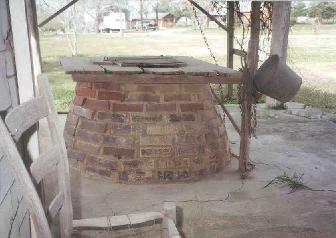
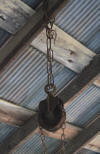
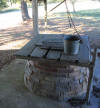
1.
"We had two wells at our home place. It seemed that having to "draw water" from the well was not a job anyone wanted to do, but it wasn't hard to do."
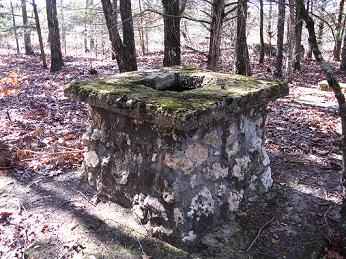 2.
2.
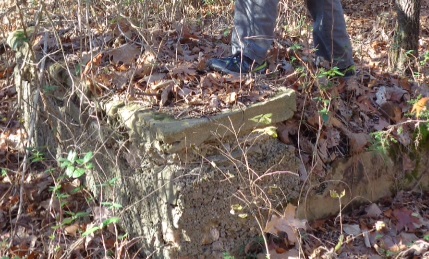
Well in the woods. Photo taken by Robert Galloway, Pencil Bluff, Dec.
2010. This old handmade well from cement and quartz rocks at a house place
that is long gone. It is right across Ridge Road from the gate you enter
to go to the old Oak Hill Cemetery near Pencil Bluff. It’s only about
30’ from the road. The well is amazingly well constructed and
still has water in it. Attached is steps. Iris are growing nearby.
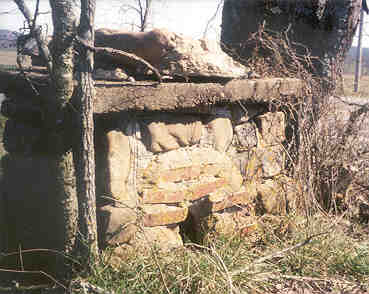 3.
3.
“Isaac’s Well”
This old well in a fence line half between Pencil Bluff and Oden is usually camouflaged with vines and is barely noticeable as you drive by except in winter. In 1931 when 50% of the village of Oden burned there was no running water and no fire department. Water had to be fetched by hand from the town folks wells, buckets were passed hand by hand. Many came from the surrounding country to help with the bucket brigade. They won a victory that night. Community cooperation saved half the town. In 1978-79 when water was low Willie Maddox on the Oden Town Council secured the grant to install the Oden-Pencil Bluff Water system. The two towns went in together to obtain a town water supply for the area for about 300 customers or 150 meters. During the December, 2000 ice storm anyone with an electric pump for their well house lost water until they obtain a generator or the power came back on.
4.
Many of the wells, in Arkansas, had a lot of iron in them, the water was bad. Then some had sulfur and that was bad. Local area maps mention Iron Springs, Sulphur Springs and Chalybeate Springs (tasting like iron). Thermal springs are also found in Montgomery Co. along the banks of the Caddo River. Cemeteries in the county sometimes had hand pumps and the Big Brushy Recreational Area still has a well. The ONFS removed the handle off the hand pump about 1995 as the water was unsafe to drink, contaminated from agricultural livestock operations.
Region's wells top in E. coli bacteria BY ROBERT J. SMITH April 5, 2009 (summerized)
The Arkansas Democrat-Gazette reviewed the 1,100 private groundwater well samples tested by the state Health Department and found to have E. coli since Jan. 1, 2004. They showed:
Private wells in Northwest Arkansas counties more commonly had E. coli than wells in other parts of the state. Benton County had 85 instances of wells with E. coli, the state's highest number. Polk and Montgomery counties, midway between Texarkana and Fort Smith, each had more than 40 wells with E. coli despite those counties' small populations. E. coli bacteria is found in the intestines of humans and other warm-blooded animals, and it's found in feces. Manure from cattle operations, poultry farms, wildlife and septic tanks can pollute wells with E. coli. A study made public on March 27 by the U.S. Geological Survey showed 7.9 percent of 397 wells studied in the U.S. contained E. coli. It showed wells with E. coli tended to have shallower depths. Health Department records show 10 percent of the 10,923 private wells tested since January 2004 contained E. coli. Not all strains of Escherichia coli make people or animals sick, but some can cause stomach pain, diarrhea or death. Hundreds of private groundwater wells are constructed every year. Licensed well contractors put in 668 private wells between July 1, 2007, and June 30, 2008, state records show. T.F., a geologist and geology supervisor for the groundwater section of the Arkansas Natural Resources Commission, estimated the state has 60,000 to 75,000 private wells in all. They serve 245,000 people, about 8.7 percent of the state's population. "I'm amazed at the wells I see out there," F. said. "There's no one out there routinely checking old wells to make sure they are still up to standard. A private well owner doesn't have to do that." If there's soil above it, it goes a long way toward filtering it out," Godfrey said. "Once it gets in the karst, it'll move fairly quickly." The area midway between Fort Smith and Texarkana has a rocky subsurface as well, although it's fractured shale related to the Ouachita Mountains rather than the Boone formation's karst, Godfrey said. What's different about the wells dug in Northwest Arkansas and those in Polk County is their depths, said Sam Harmon, the owner of Drillers Inc., a well contractor in Lowell. North Arkansas wells go down 400 feet or more, he said. "If it's dug right and the case is put in right, there's not going to be a lot of contamination," Harmon said. "A lot of groundwater has E. coli. There's no telling where it comes from. Where's anything come from?" Wells aren't so deep in Polk County and other areas of west central Arkansas, said Dean Scantling, the owner of Dean Scantling Well Drilling in Caddo Gap. Wells are usually 100 to 200 feet deep, he said. "It's more than likely septic tanks when they get polluted," Scantling said. "That's the most likely source."
Same well house but different time of year. Nov. and in the summer of June 2010. Day lilies and a sunflower in the foreground with a birdhouse. A birdfeeder and horse shoes hanging with a couple of buckets. A large vegetable garden in the background.
By the 1870s the rope and bucket in the public sixty foot hand dug well on the south east corner courthouse wore out and was replaced by a well-house with a windlass and two heavy oak buckets with iron hoops on a pulley and chain and provided a never ending source of cold clear water and a gathering place. Today, June 2001, the Mount Ida Waterworks source for water is the Cedar Creek Reservoir.
The older wells were hand dug usually were 12 to 15 feet deep. In the 50s people began using a truck with a well digger on them to dig the wells. Even the truck dug wells had long buckets on them and water was still drawn by hand. As time progressed, electric well pumps, both above ground and submersible were used and houses were plumbed to carry water into the houses. Well curbs from abandoned covered hand dug wells can still be seen in the area, without homesteads in sight.
"I have an old hand dug well in my yard, here in Mount Ida. It is not used but still has water that could be used if I wanted to."
Very few wells tested and as for as I know very few were drilled, hand dug, curbed w/concrete and usually would be located close to the back of the house and would have a pulley attached to a beam off post erected on both sides so that when the bucket was lowered into the well on rope it would center the well hole so it would not touch the wall while being drawn to the surface. People built well curbs all shapes and sizes but mostly were round concreted around the top leaving a hole larger than most 3 gal. buckets used, the lid was usually wooden and fastened to close when not in use. Many natural springs were there also, our house had one on the side hill very convenient had a nice concrete house built over so as to allow for a big refrigerator to store milk for home use. Incidentally, when I was home we carried water for home use but was later pumped. Boyce Bates, March 2009. Grew up in the Sulphur Springs area prior to 1949.
Well curb:
Watertight concrete slab at the ground surface surrounding a well. Curbing should be at least four inches thick and extend at least two feet in every direction from the well casting and slope away from the casting. The framework around the top of a well. Concrete makes the best well curb, as it keeps out the surface water, and is easily kept clean.
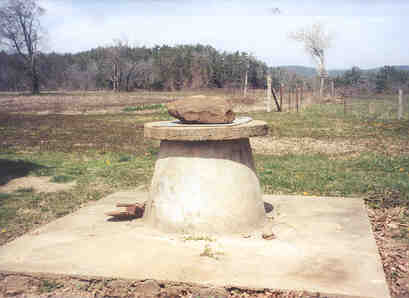
Dug wells are not very deep and were excavated below the groundwater table until incoming water exceeded the digger’s bailing rate. It was covered with a cap. The well is usually covered by a concrete curb that stands about a foot above the ground. The land surface around the well should be mounded so that surface water runs away from the well and is not allowed to pond around the outside.The top of the well above with the cover lifted. Wells down Brushy Rd.
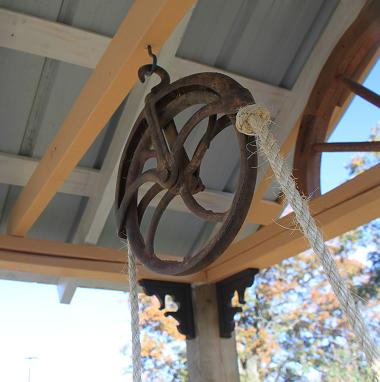
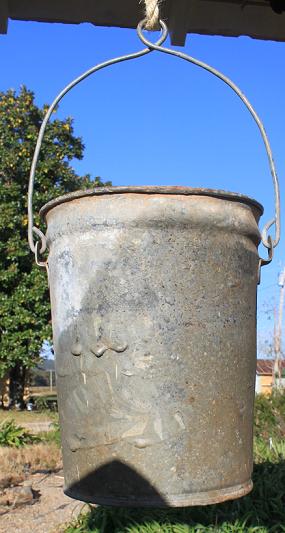
The pulley measures 12½" across the wheel guard with a 10½" diameter wheel that holds a ¾" rope. It weighs 5½lbs.
When the well's dry, they know the worth of water. B.F.

.
"Yes, there was a well at Grandpa's house for household use. Also a well by the barn and an abandoned well in one of the fields."
Mt Ida Museum well on the front porch of a log cabin
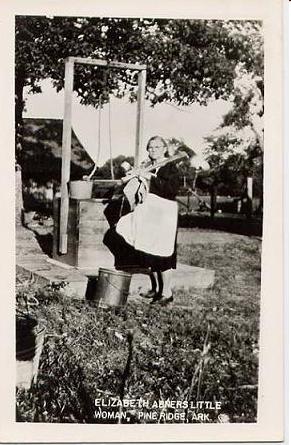
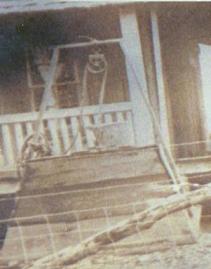
The middle photo: The well is on the old Ryals' place place west of Mena. It is
still in use today. Of course it has a different cover. It is a hand dug well
about 30 ft. deep. It was built with flat rocks gathered from nearby mountains.
The Ryals had a black washpot by the well to heat water for mama to hand rub
clothes on a rubboard. She also used it to make lye soap.
WATER WAYS By Susan Manlin Katzman
St. Louis Post-Dispatch Page: 16 23 October 1994
Why would anyone spend money for something they could have free or almost free
with the flick of a wrist? Why is water bottled water the hottest drink of the
'90s? Bottled waters are making waves. More than 800 brands are available in the
United States, up from 600 in 1988. Last year alone, sales increased by almost 7
percent. Demographic studies tells us who's doing the drinking: Most
bottled
water fans are 25 to 34 years old, and 54 percent of them are women. We know
what they are drinking: all waters flavored, unflavored, carbonated and still.
We even know the when morning, noon and night. And the where just about
everywhere. What's the scoop? Are there discernible differences from brand to
brand?
PINE VALLEY - Natural Spring Water
Source: Label states, "Source: Natural Spring in Montgomery County, Arkansas"
Paid: $1.29 for a 1.5-liter bottle.
Another Company : Alexa Springs (Montgomery County)
REMEMBERING ARKANSAS Gristmills once as
numerous as kernels on an ear of corn by Tom W. Dillard
The Arkansas Democrat Gazette 4 November 2007
Gristmills were an important part of many rural Arkansas communities from the
settlement of the state until after World War I. These mills, often powered by
falling water in the uplands and steam in the lowlands, ground corn into
cornmeal and wheat into flour. Along with cotton gins and small lumber mills,
gristmills constituted much of what passed for manufacturing in rural areas.
These mills also served an important social purpose for rural Arkansans in that
the periodic visit to the gristmill was a time for socializing. Some believe the
first gristmill in what is today Arkansas was built in Lawrence County, Missouri
Territory, in 1815. The English naturalist Thomas Nuttall made a tour of the
newly created Arkansas Territory in 1819 and reported progress was afoot: "The
privations of an infant settlement are already beginning to disappear as grist
and saw-mills now commence [to appear]." Those settlers, regardless of how tough
and independent, knew to appreciate a gristmill. Without a mill, corn had to be
pulverized by hand - a slow and tiring process - and the resulting meal was not
very good. Corn was the literal staff of life for most Arkansans in the 19th
century. Even though wheat, rye and other grains were grown on many farms, for
most areas it was corn that fed man and beast for generations. Another foreign
visitor, Henry R. Schoolcraft, observed in 1818 that Ozarkers served hot corn
bread with butter and honey. While a farmer might expect his hogs to forage for
a living, his horses and mules usually received supplemental feedings of corn in
addition to fodder. Slave owners fed their slaves mostly corn, too.
The late historian Orville W. Taylor wrote that "the high prices of wheat flour
as compared to cornmeal prevented the widespread use of wheat bread for slaves,
as well as for many of the white people of the period." Taylor noted that slaves
usually existed on meals "in which meat, [corn] meal, and molasses were among
the main components." Farmers looked forward to the corn harvest. By that point
in the year, the meal remaining in the bin might be running low - and it was
sometimes infested with weevils. John Brown of Camden, who had a plantation at
nearby Princeton, wrote gladly in his diary on Aug. 29, 1853, of having new
cornmeal.
In 1860 Arkansas produced more than 17 million bushels of corn. The census of
that year listed fewer than 254 professional millers in the state. Some of these
men worked in gristmills owned by wealthy planters, but most lived in towns and
crossroad villages throughout the state. The abundance of streams named Mill
Creek in the state reminds us how ubiquitous was the gristmill. Settlers in
north Arkansas found the abundance of springs and creeks ideal for building
water-powered gristmills. A mill dam was usually constructed to create a pond
that fed a water wheel. The wheel in turn powered one or more sets of grist
stones, called "burrs," which slowly ground corn into meal or wheat into flour.
In the lowlands mill ponds usually fed water to the steam boilers that turned
the giant stone. Sometimes a gristmill would operate in conjunction with a
cotton gin.
The Ozark gristmills could be scenic. Among the particularly handsome mills I
have seen in old photographs were the ones at Evening Shade in Sharp County and
Marble Falls in Newton County - both now long gone. By 1933 the gristmill had
become a thing of fond memories to many, including North Little Rock developer
Justin Matthews. In that year he had a concrete version of an abandoned
gristmill built near Lakewood, one of his subdivisions. Ozarks writer and
promoter Otto Ernest Rayburn wrote extensively on the gristmills, sometimes
waxing on about how tradition clings to the mills "like moss to an oak tree."
Baxter County native and well-known journalist Tom Shiras wrote wistfully in
1945 of the loss of almost all the 15 water-powered gristmills in his county.
Shiras wrote of the gristmill as "the forum of the neighborhood where all public
questions were discussed and gossip exchanged." He said this was due to everyone
having to wait while their grinding was completed, and the "time was passed in
discussion." By 1955 Rayburn could find only a handful of gristmills still
operating in the state. Old-timers grumbled about the bland nature of
mass-produced cornmeal, but their children had no problems adapting.
REMEMBERING ARKANSAS Arkansans worked hard to
get food on the table by Tom W. Dillard
The Arkansas Democrat Gazette 25 June 2006
I have just picked and eaten the first cucumbers from my garden. I hoed a long
row of purple hull peas, and gave a side dressing of fertilizer to my sweet
corn. The sweet corn is tasseling, which means it is only a few more days until
I can feast on roasting ears. Our ancestors loved this time of the year, when
the garden finally started producing fresh vegetables to relieve the monotony of
everyday fare. In the modern world with its grocery stores and specialty
markets, it is difficult to comprehend how hard our ancestors worked to put food
on the table.
If cotton was king of the crops, corn was the queen. Settlers almost always
cleared a field for corn production as soon as a house was constructed. Corn was
the staff of life for most Arkansans, whites and blacks alike. Slaves were said
to live on the "three M diet," consisting of meat, meal and molasses. The 1860
census showed that more than 17 million bushels of corn were produced in
Arkansas that year, with every county represented. In that same year, more than
250 Arkansans made their living as millers, usually grinding corn into meal.
Considering the limited variety of available food, especially in the winter, it
is not surprising that 19th-century Arkansas women put great effort into their
gardens and took pride in the results. One young wife who traveled west to
settle in Ouachita County wrote her mother back in Alabama on April 6, 1859,
with enthusiasm: "I must tell you about my garden. I have a very forward garden
I think, considering how late a start we had, have had nice mustard salad,
radishes, & lettuce for several weeks, have 4 squares set out in collards ...
have squashes & cucumbers up & growing fine. ..." Many early Arkansans turned
their corn crops into whiskey. I prefer mine as roasting ears. I already have a
pan sitting on the stove ready for those first ears.
The Woodford Iowa Yard hydrant.
Otago Witness 26 January 1884, Page 28 A Strict Father.
"My father was a very strict man with his children, said one of the supreme
judges of Arkansas, "and I don't think that I ever knew him to swerve one inch
from a fixed purpose. He looked upon a boyish prank as a violation of the family
law, and I don't think on such an occasion he ever failed to administer
punishment. One morning while the family were at breakfast I went out to the
well, unwound the chain from the windlass and let the bucket go down to the
water. I thought it would be a good joke to tell him that the bucket was in the
well, and just as he became concerned, to draw it up and have a laugh at his
expense. " Bucket's down in the well I said when I entered the dining-room. The
old gentleman didn't say anything, and I intended to correct the statement, but
bending my energies to the demands of a boy's keen appetite, I soon forgot my
joke. After breakfast the old gentleman walked to the blacksmith's shop, about
four miles distant, and had an iron hook made. He returned home, cut a long
pole, and spent some time in fitting the hook on the end of it. I noticed the
work, but it did not occur to me that I was the instigator of the performance.
When the pole was properly arranged be went to the well and began to fish for
the bucket. The bucket that I had lowered had been drawn up, but the other one
had been let down. I was afraid to say anything, so I went down to the barn and
played around a long time. Finally I went back to the house, reaching there just
as the old gentleman brought the bucket from the well. He looked at the chain,
then at the windlass, then at me.
"Didn't you tell me that the bucket was in the well?" "Yes, sir." " Don't you
know that you told me a lie ?" "But it was in the well, wasn't it?" and I
laughed, hoping to impress him with the humorous side of the affair.
"That's very funny," the old gentleman replied, " but I'd better take you in
hand, or you might be telling funny stories in the Legislature one of these
days," and taking up a limb he thrashed me until all the humour faded from the
joke.